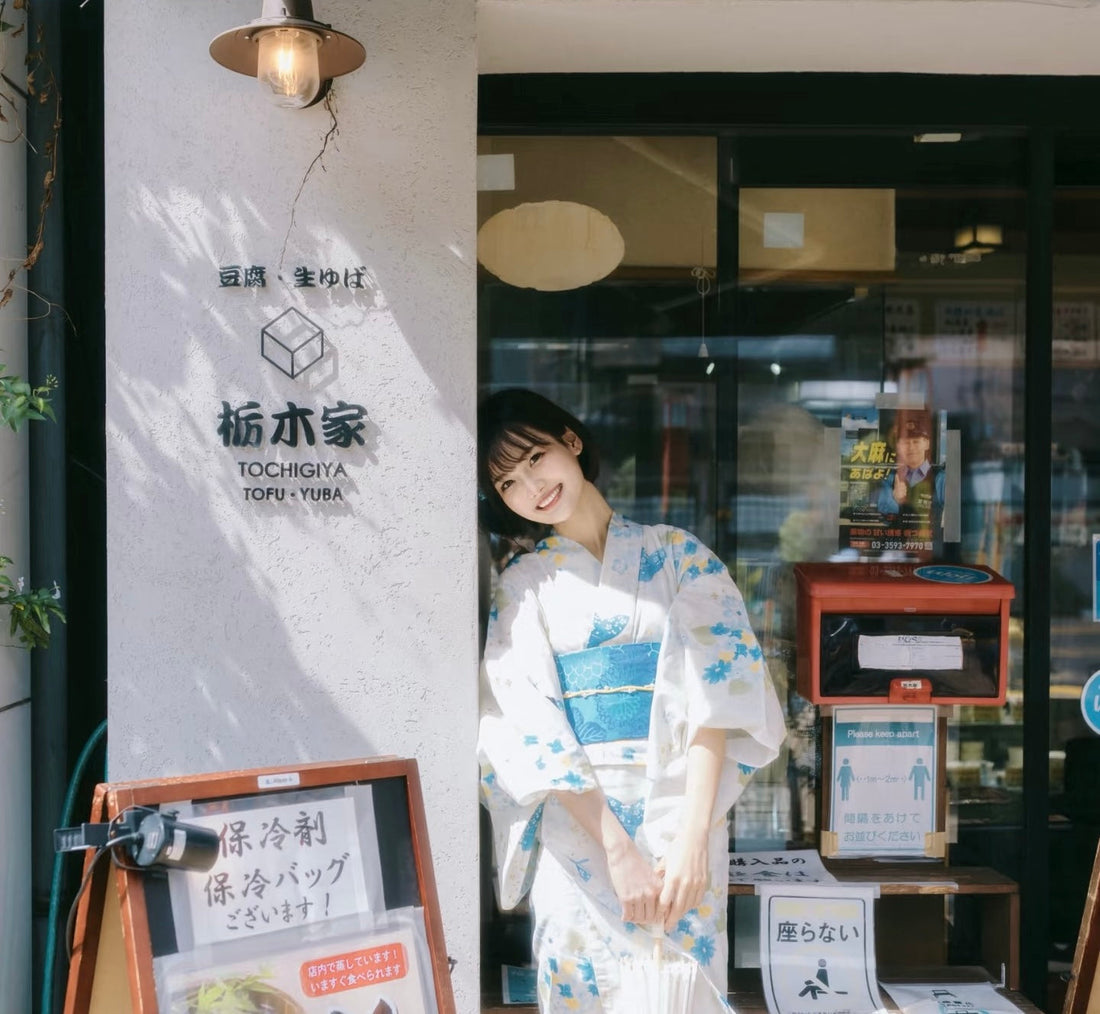
Yukata — The Global Kimono That’s Soft Power in Motion
Yukata — it’s lightweight, it’s beautiful, and it’s showing up far beyond Japanese summer festivals.
Once tucked away in history as a bathrobe for nobles, the yukata has become a quiet global fashion icon. From Tokyo to Toronto, people are slipping into this airy cotton robe not just for fireworks or onsen trips, but for Instagram photoshoots, casual hangs, and even weddings.
But what is it about yukata that makes it so enduring — and why is it suddenly everywhere?

Let’s start with the basics — what is a yukata?
A yukata is a casual kimono, made from cotton or synthetic fabric, traditionally worn during Japan’s hot and humid summers. It’s unlined, breezy, and meant to be easy to wear — unlike formal kimonos which can take hours and assistance to put on. Think of it as the t-shirt dress of Japanese tradition: understated, elegant, and full of seasonal charm.
Want to bring that effortless yukata style to your next trip? Here’s how to pair traditional silhouettes with modern travel wear — explore our airport outfit guide inspired by celebrities and creators who blend comfort with culture.
Why are people obsessed with it right now?
Because yukata are wearable nostalgia. They blend old-world heritage with modern-day ease. And let’s be honest — they photograph beautifully. Social media has helped fuel a global appreciation for the yukata's minimalist lines, rich dyes, and the ritual of wrapping yourself in something that feels like both history and home.
They're also highly versatile — whether you’re attending a fireworks show in Kyoto, lounging in a ryokan, or styling one with sneakers for an art show in Berlin, the yukata meets you where you are.
Japan didn’t just get lucky — cultural influence was intentional
In the late 20th century, Japan began to invest heavily in its soft power — cultural exports like anime, J-pop, cuisine, and fashion. The “Cool Japan” campaign was a formal recognition that culture could do what diplomacy sometimes couldn't: make people fall in love with a country.
Yukata quietly benefited from this global curiosity. It started showing up in anime and manga, in Studio Ghibli films, in fashion editorials and cosplay conventions. Designers began remixing the yukata silhouette for runways. Suddenly, wearing a yukata wasn’t just for matsuri (festivals). It was for everywhere.

But what exactly was Cool Japan — and how did it change everything?
"Cool Japan" isn’t just a catchphrase. It was — and still is — an official cultural diplomacy strategy launched by the Japanese government in the early 2000s. The goal? To promote Japan’s creative industries to the world as an export of soft power — the kind of influence that comes from admiration, not domination.
Here’s how it worked — and how it made yukata part of the story:
1. From policy idea to action: the Cool Japan Fund
In 2013, Japan launched the Cool Japan Fund, a public-private investment vehicle backed by the Ministry of Economy, Trade and Industry (METI). With over $1 billion USD in funding, the government invested in:
- Fashion and textiles (yes, yukata included)
- Anime, manga, and film exports
- Traditional crafts and design
- Japanese food and drink industries
- Tourism and cultural experience businesses
- E-commerce platforms to sell Japanese-made goods globally
Instead of just advertising Japan, they co-funded companies that could make Japanese culture stick abroad.
2. Fashion: Where tradition met innovation
From kimono cooperatives to runway designers, the fund supported:
- Revival of indigo dyeing, traditional weaving, and hand-printing
- Fashion brands that blended streetwear with yukata
- Pop-ups in Paris and Milan featuring yukata as fashion
- Online stores with global shipping and multilingual support
Suddenly, yukata weren’t just tradition — they were trend.

3. Anime, pop culture, and global fans
Cool Japan also co-funded global anime distribution, cosplay conventions, and licensing deals for Japanese brands. Influential figures emerged:
- Kyary Pamyu Pamyu – Harajuku pop icon
- Takashi Murakami – artist fusing manga and Edo art
- Makoto Shinkai – filmmaker who popularized yukata scenes
- NIGO® – streetwear designer blending samurai aesthetics and hype culture
Thanks to them, yukata were not only worn in real life — they were everywhere online.
4. Tourism and yukata-as-experience
Cool Japan invested heavily in inbound travel. Ryokans gave guests yukata to wear. Temples and tea houses offered yukata dress-up photos. Onsen towns revived yukata festivals to attract foreigners.
Tourists didn’t just buy yukata — they lived in them for a weekend. Cultural immersion became the best form of branding.
5. Digital-first, global next
From Shopify yukata shops to anime-themed yukata on Etsy, the government quietly supported businesses exporting tradition. Media sites like Tokyo Otaku Mode and ZenMarket received early Cool Japan attention. Yukata went from rural inns to digital carts in New York, Paris, and Jakarta.
Yukata didn’t stay frozen in time — they evolved
Originally used as bathrobes by nobles during the Heian period, yukata found their way into public life during the Edo era. Townspeople wore them to public baths and summer events. They were easy to wash, breathable, and democratized elegance.
Fast-forward to now, yukata exist in:
- Soft pastel gradients
- Digitally printed neon or anime themes
- Zip-up versions with pre-tied obi
- Genderless, oversize, or street-styled variations
A quick style guide — which yukata is right for you?
- Classic yukata: Cotton, floral or wave motifs, indigo or white. Worn at fireworks festivals or shrine visits.
- Modern yukata: Pop culture prints, Instagram-ready. Popular at cosplay or fashion events.
- Ryokan yukata: Minimalist stripes. Meant for sleeping, lounging, or bathhouse trips.
- Children’s yukata: Bright, playful, easy to wear with Velcro or elastic.
Some are so beginner-friendly they wrap and tie like a bathrobe — but still carry centuries of tradition.

How to wear a yukata (and avoid mistakes)
- Always wrap left over right. The other way is for the deceased.
- Tie the obi belt at your waist. For women, a bow at the back. For men, low and flat in front or back.
- Slip on geta (wooden sandals) or modernize it with sneakers.
- Optional: a folding fan, small kinchaku bag, or a paper umbrella.
So what does yukata mean today?
It’s not just a seasonal garment. It’s living history — breathable, wearable, and made to move.
Wearing a yukata in 2025 connects you to:
- A Heian-era bathhouse
- A Taisho-era street festival
- A 2000s anime dream
- And your own story, wherever you live
It’s not about dressing like someone else — it’s about dressing with meaning.
Interested in how other cultures preserve elegance through clothing? You might enjoy our complete guide to Hanfu — China’s own timeless, flowing counterpart to the yukata.
